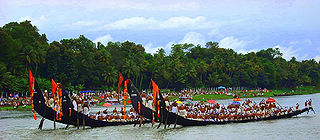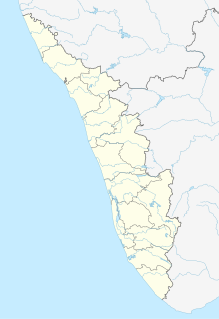
Alappuzha is one of the 14 districts in the state of Kerala in India.It is the smallest district in Kerala. It was formed as Alleppey District on 17 August 1957. The name of the district was officially changed to Alappuzha in 1990. Alleppey town was renamed Alappuzha in 2012, even though the anglicised name is still commonly used to describe the town as well as the district. The district is best known for its picturesque backwaters.

Ambalappuzha is a small town in the Alappuzha district of Kerala state, south India. It is located 14 km south of Alappuzha which is the district headquarters.

Guruvayurappan also often written Guruvayoorappan, is a form of Vishnu worshipped mainly in Kerala. He is the presiding deity of Guruvayur temple, who is being worshiped as Shri Krishna in his child form, also known as Guruvayur Unnikkannan. Even though the deity is that of chaturbahu Vishnu, the concept (Sankalpam) of the people is that the deity is the infant form of Lord Krishna. The deity represents the purna rupa revealed by baby Krishna to his parents Vasudeva and Devaki immediately after his advent in Kamsa's jail. So this is the reason why baby Krishna is worshipped on a Vishnu deity. The temple is located in the town of Guruvayur, Thrissur district, Kerala, India, which is named after the deity itself.

Velakali is a traditional martial dance of Nair community of Kerala that is performed during temple festivals. Brightly dressed dancers wielding swords and shields depict a fight sequence between the Pandavas and Kauravas during the course of the dance.

The Padmanabhaswamy temple is a Hindu temple located in Thiruvananthapuram, the state capital of Kerala, India. The name of the city of Thiruvananthapuram in Malayalam translates to "The City of Lord Ananta", referring to the deity of the Padmanabhaswamy temple. The temple is built in an intricate fusion of the Chera style and the Dravidian style of architecture, featuring high walls, and a 16th-century gopura. While the Ananthapura temple in Kumbla is considered the original seat of the deity ("Moolasthanam"), architecturally to some extent, the temple is a replica of the Adikesava Perumal temple in Thiruvattar.

Hanuman Janmotsava is a Hindu religious festival that celebrates the birth of Hindu God Hanuman, who is immensely venerated throughout India and Nepal. This festival is celebrated on different days in different parts of India. In most states of India, the festival is observed either in Chaitra or in Vaishakha, while in a few states like Kerala and Tamil Nadu, it is celebrated in Dhanu.

The Aranmula Boat Race the oldest river boat fiesta in Kerala, the south western State of India is held during Onam (August–September). It takes place at Aranmula, near a Hindu temple dedicated to Lord Krishna and Arjuna in Pathanamthitta district of Kerala State. Its more of a ritual conducted on the birthday of Arjuna, than a race event. The snake boats move in pairs to the rhythm of full-throated singing and shouting watched by an exciting crowd. In 1972, snake boat races were also added to the program of the festival. Thousands of people gather on the banks of the river Pampa to watch the snake boat races. In 2019 Fifty Two snake boats or Palliyodams had participated in the festival. The oarsmen sing traditional boat songs Vanchippattu and wear white mundu and turbans. The golden lace at the head of the boat, the flag and the ornamental umbrella at the center make it a show of pageantry too.

The Champakulam Moolam Boat Race is one of the oldest vallam kali in Kerala state of south India. The race is held on the River Pamba on Moolam day of the Malayalam month Midhunam, the day of the installation of the deity at the Ambalappuzha Sree Krishna Temple.

Valla Sadya is a celebration in the Hindu temple at Aranmula, Kerala, India. During the festival the village conducts a snake boat race in the Pampa River, and there is a feast at the temple. The Valla Sadhya is conducted on Ashtamirohoni day. During Valla Sadhya, Lord Krishna, the main deity worshipped in the temple, will come to take the offerings from people. The legend is that in a Valla Sadya all dishes asked for must be given to the people in order to please the lord.

Thiruvangad Sree Ramaswami temple is an important temple located in the east part of Thalassery. The temple is generally known as the Brass Pagoda from the copper sheeting of its roof. A part of the temple was damaged by Tipu Sultan's troops in the 18th century, but the temple itself is believed to have been saved from destruction. It was one of the outposts of the Thalassery fort in the eighteenth century. In its precincts were held many conferences between the officials of the East India Company and local leaders, at which political treaties and agreements were signed. The temple contains some interesting sculptures and lithic records. The annual festival of temple commences on Vishu day in Medam (April–May) and lasts for seven days.

Vilwadrinatha Temple is a Hindu temple located in Thiruvilwamala, Thrissur district of Kerala. Lord Rama, the seventh avatar of Lord Vishnu, and his brother Lord Lakshmana are the main deities of this temple. This is one of the four major temples in Kerala dedicated to Lord Rama, the other three being Thriprayar, Kadavallur and Thiruvangad temples, and also one of the rarest temples in India itself which houses Lord Lakshmana. The temple is situated on the middle of Thiruvilwamala village, on the top of a hill 100 ft above the sea level. Bharathappuzha, the second largest river in Kerala, flows through the northern side around 3 km away from the temple, and as the temple is situated on the top of a hill, the river can be clearly seen from the temple.
Vilwamangalam Swamiyar or Vilwamangalathu Swamiyar is the name of more than one saint who lived in India. The first Vilwamangalam, a Swamiyar belonging to Naduvil Madhom, who lived in the 8th century. The spot of his samadhi is to the west of Sree Padmanabhaswamy Temple. The second saint who belonged to Thekke Madhom,Thrissur lived during the middle of 14th century. He was an ardent devotee of Lord Guruvayoorappan. Both the Swamiyars were native to Malai Nadu. The first Swamiyar was born in Sukapuram Gramam in Kerala. The second Swamiyar was renowned all over India. Bengalis believe that he was born in Bengal while Oriyans believe in Orissa, though tradition in Kerala implies that he belonged to Panniyoor village. "Sreekrishna Karnamritham" is his devotional masterpiece, written under an unspecified name "Leelasukan". The second Vilwamangalam is closely associated with several famous temples in Kerala such as Thiruvarppu, and Cherthala Kaarthiaayani.
The Sree Narayana Jayanthi Vallam Kali or Boat Race, at Kumarakom, Kerala is held in September every year during Onam festival. More than 1,000 oarsmen in boats of different sizes and shapes participate. Even though snake boats participate in this race, the importance is given here is for iruttukuthi, in which about 50 oarsmen row. The successful iruttukuthi wins the Sree Narayana Ever Rolling Trophy.

Anandavalleeswaram Sri Mahadevar Temple in Kollam city is one of the ancient Hindu temples in Kerala, India. Lord Siva and Goddess Anandavally are the main deities of the temple. According to folklore, sage Parashurama has installed the idol of Lord Shiva. The temple is a part of the 108 famous Shiva temples in Kerala. It is located at Anandavalleeswaram, a major neighborhood of Kollam city, that comes to the west side of Kollam Collectorate.

Kaviyoor Mahadevar Temple is one of the important Siva temples in Kerala, located in Kaviyoor, Tiruvalla Pathanamthitta District, Kerala, India. It is commonly called Thrikkaviyoor Mahadeva Temple. The main deity is Lord Mahadeva (Shiva) with Parvathi.The temple is well known for the Hanuman temple situated inside the temple complex. Kaviyoor Temple is one of the important Special Grade temples under the Travancore Devaswom Board.

Janardana Swami Temple is a 2000-year-old temple situated in the municipality of Varkala city in Trivandrum. It is also known as Varkala Temple. Janardana Swami is a form of Lord Vishnu. It is a very well known temple in Kerala about 10.9 km west of Kallambalam on NH 66 near sea, 25 km north of Thiruvananthapuram city, 8 km south of famous backwater destination Kappil and 2 km from Varkala Railway Station,14 km north west of Attingal municipality. It is situated near the Arabian sea shore.It is referred to as Dakshin Kashi. The temple is located close to the Varkala Beach, which is considered to have medicinal properties since the waters wash the nearby medicinal plants. It is also an important Ayurveda treatment center. The temple has an ancient bell removed from a shipwreck, donated by the captain of the Dutch vessel which sank near Varkala without causing any casualties.

Evoor Major Srikrishnaswamy temple is a Krishna temple in Evoor near Haripad, Alappuzha, Kerala. It is said to have originated five millennium ago following Khandava Dahanam. Temple in its current form is built by Moolam Thirunal.

Kanipura Sri Gopalakrishna Temple at Kumble is an ancient temple and is situated eight miles due north of Kasaragod town. According to local religious beliefs, the Krishnashila Idol of the Lord Bala Gopalkrishna, having the features of a child, which was worshipped by Lord Krishna's foster mother Yashoda, is believed to have been presented by the almighty Lord Krishna himself to the sage Kanva Maharshi in Dvapara Yuga, who in turn installed the same at its present location where the temple exists. Historical records state that in the 10th Century, the Temple was renovated by King Jayasimha of Kadamba Danasty, whose capital was Kumbla and even the administration of his Kingdom was being done in the name of Kanipura Sri Gopalkrishna. The coronation of Kumbla Rajas was being solemnized at Kanipura Sri Gopalkrishna Temple.
Peroor Sree Krishna Swamy Temple is an ancient Hindu Temple situated near Ambalamukku in Thiruvananthapuram Municipal Corporation. Ambalamukku Jn is 6 km from Thiruvananthapuram central Bus Stand and Railway Station. The temple is dedicated to Lord Sree Krishna and is administered by Travancore Devaswom Board. Peroorkada's name came from this holy temple. The temple is famous as 'Thekkan Guruvayoor'..





















